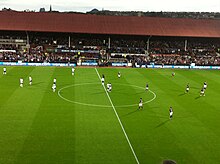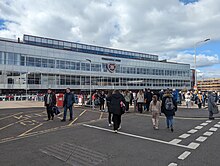28th July 2007
 In Scotland, Heart of Midlothian FC has had its home at Tynecastle Park in Edinburgh since 1866. The record attendance at that ground was set on 13th February 1932, when 53,396 were present for a Scottish Cup tie against Rangers. In more recent years though the Tynecastle capacity has been as low as under 20,000 so when mighty Barcelona visited the Scottish capital for a pre-season friendly against Hearts, the venue was switched to the nearby Murrayfield Stadium, the home of the Scottish Rugby Union. And after over 150 years at Tynecastle that match on Murrayfield - played on Saturday 28th July 2007 - saw a new home record attendance for a Hearts match being set.....57,857. It wasn't the first time that Hearts had temporarily moved home to Murrayfield. In the 2000s they played six home Champions League/UEFA Cup matches at Murrayfield, as Tynecastle wasn't up to UEFA standards - top crowd 32,459 v AEK Athens. Later, in 2017/18, they played their first four home League matches of the season at Murrayfield due to building work at Tynecastle - top crowd 32,852 v Rangers. And the match against Barcelona - Ronaldinho gave the visitors the lead from a 21st minute penalty, Juho Makela equalised, Ronaldinho restored the Barca lead before sub Thierry Henry set up Giovanni Dos Santos to score the final goal in the Spaniards 3-1 victory.
In Scotland, Heart of Midlothian FC has had its home at Tynecastle Park in Edinburgh since 1866. The record attendance at that ground was set on 13th February 1932, when 53,396 were present for a Scottish Cup tie against Rangers. In more recent years though the Tynecastle capacity has been as low as under 20,000 so when mighty Barcelona visited the Scottish capital for a pre-season friendly against Hearts, the venue was switched to the nearby Murrayfield Stadium, the home of the Scottish Rugby Union. And after over 150 years at Tynecastle that match on Murrayfield - played on Saturday 28th July 2007 - saw a new home record attendance for a Hearts match being set.....57,857. It wasn't the first time that Hearts had temporarily moved home to Murrayfield. In the 2000s they played six home Champions League/UEFA Cup matches at Murrayfield, as Tynecastle wasn't up to UEFA standards - top crowd 32,459 v AEK Athens. Later, in 2017/18, they played their first four home League matches of the season at Murrayfield due to building work at Tynecastle - top crowd 32,852 v Rangers. And the match against Barcelona - Ronaldinho gave the visitors the lead from a 21st minute penalty, Juho Makela equalised, Ronaldinho restored the Barca lead before sub Thierry Henry set up Giovanni Dos Santos to score the final goal in the Spaniards 3-1 victory.The Hearts club was formed in 1874, the club played at sites in The Meadows, Powburn and Powderhall (need a map?). Hearts first moved to the Gorgie area, in the west of Edinburgh, in 1881.This pitch, known as "Tynecastle Park" or "Old Tynecastle", stood on the site of the present-day Wardlaw Street and Wardlaw Terrace. As this site was then regarded as being 'out of town', Hearts would sometimes stage two matches for the price of one, or set an admission price much lower than Edinburgh Derby rivals Hibs. In 1886, with the city continuing to expand, tenement blocks replaced the old ground and Hearts moved across Gorgie Road to the present site (also known as "Tynecastle Park", or "New Tynecastle"), which was leased from Edinburgh Corporation. Hearts played a friendly against Bolton Wanderers to inaugurate their new home on 10 April 1886. Tynecastle staged its first Scottish League Club match on 23 August 1890, when Hearts lost 5–0 to Celtic.
Hearts won the Scottish Cup in 1891, which provided the club with sufficient finances for a new clubhouse. Tynecastle hosted its first international fixture in 1892, a 6–1 victory for Scotland against Wales. Only 1,200 fans attended the match because a snowstorm had led many fans to assume that it would be postponed. 1892 also saw a roof constructed on the original "South" stand. In 1895 Tynecastle hosted a "World Championship" match between the winner of the English Football League First Division, Sunderland, and the Scottish league champions, Hearts. The trophy was won by Sunderland, who beat Hearts by a 5–3 score. Tynecastle hosted another "World Championship" game in 1902, when Hearts beat Tottenham Hotspur 3–1.
Tynecastle underwent substantial changes in the early twentieth century. A small stand and pavilion were built in 1903. The banks of terracing were greatly increased in 1906, giving a total capacity of 61,784. In 1911, a covered enclosure was erected on the western "distillery" side. The two old stands and pavilion were replaced in 1914 by a pitch-length grandstand (the present Main Stand), designed by the renowned stadium architect Archibald Leitch. To partly fund the cost of the new stand, Hearts sold Percy Dawson to Blackburn Rovers for a British record transfer fee of £2,500. A number of items were omitted from the first estimate of the stand, which meant that its cost doubled to £12,000.
Hearts purchased the ground in 1926. Over the next four years, the terraces were expanded using ash from the nearby Haymarket Railway Yards. In 1927, Hearts gave the BBC permission to begin radio commentaries from the ground. New turnstiles were built on Wheatfield Street and subways created to allow access to the terraces.Tynecastle's record attendance was achieved in 1932, when 53,396 attended a Scottish Cup tie against Rangers. Tynecastle was now tightly squeezed on three sides, however, by narrow streets, Tynecastle High School and bonded warehouses of the North British Distillery. Hearts considered moving to Murrayfield Stadium, which had opened in 1925. There was also a proposal to move to a new ground in Sighthill. The start of the Second World War halted these schemes, however.
The terraces were concreted in 1951 and Tynecastle became Scotland's first all-concrete stadium in 1954. Following the modernisation of the stadium, the club architects said that the capacity stood at 54,359, but for safety reasons only 49,000 tickets were printed and sold for big matches. Floodlights were installed at Tynecastle in 1957. A roof was constructed along part of the "distillery" side and in the north-west corner of the ground in 1959. This work was paid for by the sale of Dave MacKay for £32,000 to Tottenham Hotspur.
No further changes were made to Tynecastle until stricter ground safety regulations came into effect in the 1970s. Hearts also lacked the finances to redevelop Tynecastle, as the club were relegated from the Scottish Premier League three times in five seasons in the late 1970s and early 1980s. Hearts began to perform better under the ownership of Wallace Mercer, who took control in 1981. The capacity was cut to 29,000 with the installation of benches on the "distillery" covered terrace and in the Main Stand paddock in 1982 and 1985 respectively. Also around this time, lounges and facilities were installed in the Main Stand.
In 1994, the entire western and northern sides of the ground were demolished, allowing for the construction of the Wheatfield Stand that year and the Roseburn Stand the following year. Temporary 'bucket' seating was installed on the (southern) Gorgie Road end terracing. That terracing was itself razed in 1997 and replaced by the Gorgie Stand. During this period of redevelopment, the ground was officially renamed as Tynecastle Stadium.
Sale and Hearts ownership In 2004, then club CEO Chris Robinson announced plans to sell Tynecastle, which he claimed was "not fit for purpose". Hearts would have rented Murrayfield from the SRU instead. The prime motivation for this move was to eradicate the club's debt of nearly £20 million. The plan was almost universally unpopular with supporters, and a campaign, entitled "Save Our Hearts", was set up to try to block the move. In spite of this, Robinson and those supporting his actions controlled a slender majority of the issued shares and it appeared that a sale would be completed, particularly after a deal was preliminarily agreed to sell the site for just over £20 million to Cala Holmes, a property development company.
The sale was cancelled, however, when Vladimir Romanov purchased the club in January 2005, invoking a clause in the initial agreement that allowed for its annulment upon the payment of a fixed sum of £75,000. Later in 2005, the pitch dimensions were altered to meet UEFA standards, necessitating the removal of the lowest rows of seating in the Gorgie and Roseburn Stands. As a result, the overall capacity was reduced from 18,000 to 17,420. On 20 August 2007 the club announced they were "at an advanced stage" in plans for demolishing the aged Main Stand and replacing it with a 10,000 seat stand, including a hotel and leisure facilities. A planning application was lodged with Edinburgh City Council in February 2008. This development would have increased capacity to 23,000, but the proposal did not proceed due to the state of the club's finances.
Redevelopment plans
The plans for redevelopment of the main stand were rekindled in December 2015, when Hearts owner Ann Budge said work on the new stand would commence as soon as possible. Hearts submitted plans in March 2016 to Edinburgh Council, proposing a new 7000-seat stand. The plans also include a nursery, alongside space for a club shop, ticket office and admin office. Construction began during the latter part of the 2016–17 season. In April, Hearts announced their intention to restore the original name of Tynecastle Park when the new stand is opened. The project was initially expected to be completed by September 2017, but construction delays meant that four home fixtures had to be moved to Murrayfield. Tynecastle re-opened on 19 November, for a league game against Partick Thistle.



Tynecastle is an all-seated stadium. The Main Stand was rebuilt in 2017, replacing an older facility designed by noted football stadium architect Archibald Leitch. The three other stands were constructed between 1994 and 1997, with all having a distinctive goalpost roof structure made out of steel tubes. Unusually, the framework sits at the front of each stand, which means that the support towers sit within 10 yards of the corner flag, forming an arch over the stand. The stadium floodlights sit on top of the support towers, angled down towards the pitch, like the lighting rigs used at concerts. The Wheatfield Stand, which seats just under 6,000 people, slopes at just under 34 degrees, the maximum angle permitted. The Roseburn Stand (School End) was completed in August 1995 and cost £1.4 million to build. The Roseburn Stand seated 3,676 when it was opened, but 280 seats were removed from both it and the Gorgie Stand when the pitch was lengthened in 2005 to meet UEFA requirements. The Gorgie Stand, which was completed in September 1997, contains the Gorgie Suite.
Other football matches: Tynecastle has been a home venue for the Scotland national football team on nine occasions. It regularly played host to the British Home Championship match with Wales, which was considered to have the least box-office potential and was often played outside Glasgow. After the Second World War, however, the Scottish FA favoured playing all home matches at Hampden Park, unless exceptional circumstances prevented Scotland playing there. More recently, Tynecastle has become the home of the Scotland Women's National team.
No comments:
Post a Comment